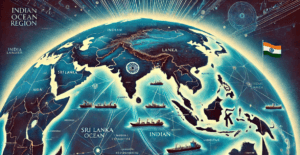India as a Unifier in the Indian Ocean Region: Strengthening Maritime Diplomacy and Security
India must take on a leadership role in the Indian Ocean Region (IOR), a strategically vital area for the country. Despite its significance, the region lacks strong institutions for cooperation, with past initiatives struggling to gain momentum. The annual Indian Ocean Conference (IOC) has emerged as an important platform, focusing on maritime security under India’s SAGAR initiative. External Affairs Minister S. Jaishankar highlighted key challenges, including Middle East conflicts and South China Sea tensions. India’s maritime diplomacy, especially through the Navy, plays a crucial role in regional stability.
Notably, India’s rapid response to the 2004 tsunami showcased its capability as a first responder. Strengthening this role requires better MoD-MEA coordination, enhanced Maritime Domain Awareness (MDA), and investments in security and humanitarian assistance. India also aids neighboring nations in safeguarding their exclusive economic zones. Maritime diplomacy extends beyond soft power, allowing deterrence and conflict prevention. For long-term success, India needs a coordinated national security strategy.

India as a Unifier in the Indian Ocean Region: Strengthening Maritime Diplomacy and Security
India must step up as a unifying force in the Indian Ocean Region (IOR), a strategically vital area for the country. In 1945, diplomat K.M. Panikkar emphasized that while other nations may see the Indian Ocean as just another maritime space, for India, it is a lifeline. However, his vision of fostering a shared regional identity has largely been overlooked outside of naval circles.
The IOR has struggled to establish strong regional institutions or frameworks for cooperation. Unlike other regions, its diversity and competing national interests have hindered the formation of effective security partnerships. Various organizations, such as IORA, SAARC, and BIMSTEC, have been created over the years, but most have failed to make a meaningful impact—except for the Indian Ocean Naval Symposium (IONS). Additionally, the growing focus on the U.S.-led “Indo-Pacific” strategy has further diverted attention from regional initiatives.
Amid these challenges, the Indian Ocean Conference (IOC), held annually since 2016, has emerged as a key platform. Organized by India’s Ministry of External Affairs and the India Foundation, a think tank linked to the ruling BJP, the IOC promotes regional cooperation under Prime Minister Narendra Modi’s “Security and Growth for All in the Region” (SAGAR) initiative, launched in 2015. At the latest IOC meeting in Muscat, External Affairs Minister S. Jaishankar addressed pressing issues, including Middle East conflicts, threats to international shipping from Houthi rebels, and rising tensions in the South China Sea due to China’s actions. He emphasized the importance of honoring agreements and maintaining predictability for regional stability.
Jaishankar also highlighted India’s contributions to economic, environmental, and security challenges in the IOR, outlining ten key initiatives. These efforts align with India’s 2007 Maritime Strategy, which underscores the Navy’s role in supporting foreign policy. However, a long-standing debate persists over India’s reliance on soft power—such as yoga, cultural diplomacy, and Bollywood—versus the need for a stronger military presence to achieve global influence. Many argue that combining soft power with strategic military capability would better serve India’s foreign policy objectives.
India’s maritime diplomacy gained global recognition in 2004 when its Navy swiftly provided humanitarian aid following the Indian Ocean tsunami—not only to Indian citizens but also to Sri Lanka, the Maldives, and Indonesia. This reinforced India’s image as a dependable regional partner, a role further solidified through subsequent rescue missions during crises. To strengthen its position as a “first responder” and preferred security partner in the IOR, India must invest in critical resources such as amphibious ships for disaster relief and a dedicated hospital ship. Additionally, improving coordination between the Ministry of Defence and the Ministry of External Affairs is essential to enable faster and more efficient emergency responses.
Enhancing Maritime Domain Awareness (MDA) is another priority. By sharing real-time data on maritime activities with neighboring countries like Seychelles, Mauritius, the Maldives, and Sri Lanka, India is helping island nations safeguard their exclusive economic zones from illegal fishing and smuggling. These initiatives demonstrate how maritime diplomacy can range from cooperation to enforcement. While warships are primarily designed for defense, they also serve as diplomatic tools, especially in an era of rising geopolitical tensions.
For India to fully leverage its maritime influence, it must integrate the efforts of its Navy, government agencies, and diplomats into a cohesive strategy. This requires a “whole-of-government” approach where all stakeholders work together under a unified national security framework—something India has yet to develop fully. By bridging these gaps and balancing both hard and soft power, India can solidify its role as a stabilizing force in the Indian Ocean Region, ensuring security and growth for all. The way forward demands not just strategic vision but also decisive action.
You must be logged in to post a comment.